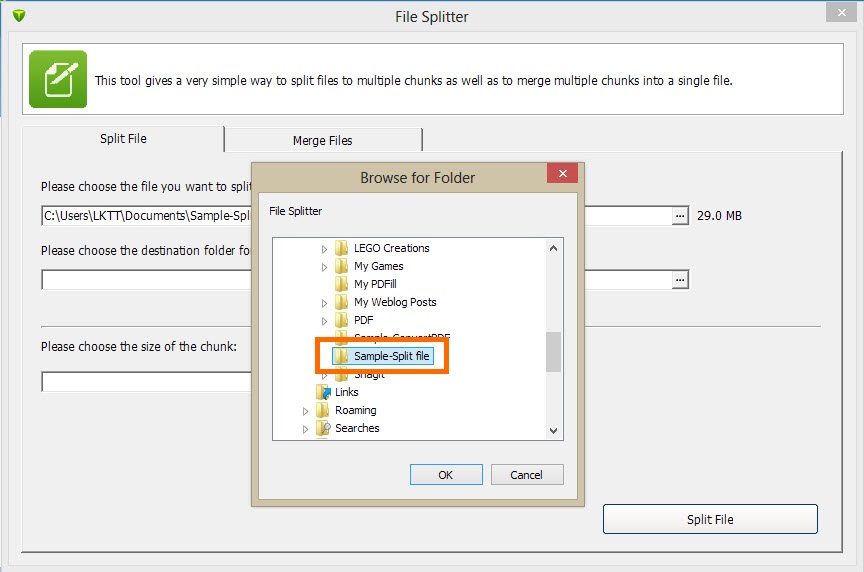

Standard, 2 GiB, Pro 64, unlimited ĪNSI, OEM, EBCDIC, ASCII, Mac, Unix, UTF-8 The following is a comparison of notable hex editors.ĪNSI, OEM, Unicode, UTF-8, EBCDIC, CustomĪVR, Java, x86, i386, x86-64, ARM/ XScale, PowerPC, PPC64 JSTOR ( July 2007) ( Learn how and when to remove this template message).Unsourced material may be challenged and removed.įind sources: "Comparison of hex editors" – news Please help improve this article by adding citations to reliable sources. $Files = Get-ChildItem -Path "$ParentDirectory\$OutputName.This article needs additional citations for verification. $OutputName = $NameWithoutExtension.Split(".")
SPLIT FILE 010 EDITOR CODE
Open a text editor and copy the following code on the editor.Change their names as name.xx.extension, where xx represents the part number, for e.g., music.00.mp3.Make sure the files you want to join have the same extension (not just in name) are present in the same location.Then, follow the instructions below to join the files: To Join the Fileįirst, ensure that PowerShell’s execution policy allows running scripts ( see the above section). You can also open PowerShell, change the directory to the Split.ps1 file’s location and enter. Navigate to and select the the output folder and click Ok.Enter the size you want for each split part.Navigate to and select the file you need to split.Right-click on it and select Run with PowerShell.Set Save as type to All files and File name to Split.ps1.Split-File -SavePath $SaveFileBrowser.SelectedPath -Path $FileBrowser.FileName -PartSizeBytes $NumBytes -Verbose $NumBytes = 1024*1024*($NumMB -as ) # This section converts the MB input to bytes $NumMB = read-host -Prompt "Enter Size in MB" # Ask for size # CHANGE THIS SECTION to ask for size in other units ::WriteAllBytes($chunkFileName, $Output)Īdd-Type -AssemblyName # Use the final chunk as the last part by shrinking the bytesize # For the final part, where the chunksize is less $chunkFileName = "$SavePath\$NameWithoutExtension.$Extension" -f $Count $ReadBytes = $ReadFile.Read($Chunk, 0, $Chunk.Length) $TotalPartsCount = ::Log10(($OriginalFile.Length / $PartSizeBytes) + 1) + 1 $OriginalFile = New-Object System.IO.FileInfo($Path) # Calculate total number of chunks possible $ParentDirectory = ::GetDirectoryName($Path) $NameWithoutExtension = ::GetFileNameWithoutExtension($Path) # Get separate parts of filename to construct new names Copy the following code on the text editor:.If you want more information, please refer to our article on Running Scripts Is Disabled On This System.Īfter changing the execution policy, follow the instructions below: To change it, enter Set-ExecutionPolicy -Scope CurrentUser -ExecutionPolicy RemoteSigned. If it shows Restricted, Undefined or AllSigned, you can’t run the script. You can type powershell on Run and press Ctrl + Shift + Enter to run it as admin.
SPLIT FILE 010 EDITOR WINDOWS
To Split the Fileįirst, open Windows PowerShell as admin and enter the command Get-ExecutionPolicy -Scope CurrentUser. If you want to split using any other sizes, you can change the code as we have directed in the comments (lines followed by #). You can use it to create split files with an input MB size. Since most people need to split a file according to a particular size, our custom script implements only this feature. So, we have created a user-friendly custom PowerShell script for splitting and rejoining a file to help you out. Windows does not have a built-in utility or app to split a file. Here are the methods you can use to split files in Windows: Split Files Using a Custom Script


 0 kommentar(er)
0 kommentar(er)
